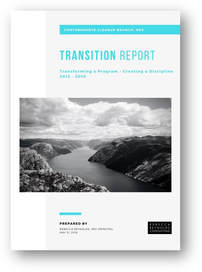CASE STUDIES: Technology Solutions

National Park Service (NPS), Contaminated Site Cleanup
Since 1916, NPS has been entrusted with the care of our national parks. The NPS mission is to preserve unimpaired the natural and cultural resources and values of the National Park System for the enjoyment, education, and inspiration of this and future generations. Addressing contamination resulting from historic land use and/or operational activities is central to this mission.
RRC was hired to conduct a strategic assessment followed by a strategic planning process for the Contaminated Sites Program (CSP). This program was directly managing about 24 of NPS's most complex cleanup projects. However, as the cleanup capability grew, more and more sites were brought to this small shop. Capacity was far below what was needed to meet the demand. The strategy called for discontinuing the program's emphasis on direct management, and instead on developing the agency's field capacity by creating consistent best practices and developing a cadre of cleanup practitioners. The transformation of CSP's business model would rely heavily on identifying and designing technology solutions and working with a variety of NPS and Department of Interior (DOI) programs to implement them.
RRC led the transformational effort, with a strong focus on developing an array of integrated IT solutions:
CSPortal: the online "manual" complete with tools and templates, as well as automated workflows, that the field can access 24/7 from anywhere.
Team Workspaces: a templatized online collaborative environment to promote greater consistency across cleanup teams and reduced dependence on email for communications and doc review.
Site Inventory: an online database of all sites, with mapping and automated updating capability. In addition, a standard and automated methodology for categorizing sites based on a dozen key data inputs was added so that the agency can easily compare sites (apples to apples) and also establish a cost-of-cleanup value.
Strategic Prioritization & Funding Allocation: with the total cost of cleanup of the Site Inventory estimated at more than $2B, prioritization of which sites to activate and fund for cleanup became a high priority. RRC suggested NPS consider using decision support software to address this complex task, and once approved, RRC led the build-out of the model. This was piloted for real-time decisions in 2019 and continues to be utilized annually.
Since 1916, NPS has been entrusted with the care of our national parks. The NPS mission is to preserve unimpaired the natural and cultural resources and values of the National Park System for the enjoyment, education, and inspiration of this and future generations. Addressing contamination resulting from historic land use and/or operational activities is central to this mission.
RRC was hired to conduct a strategic assessment followed by a strategic planning process for the Contaminated Sites Program (CSP). This program was directly managing about 24 of NPS's most complex cleanup projects. However, as the cleanup capability grew, more and more sites were brought to this small shop. Capacity was far below what was needed to meet the demand. The strategy called for discontinuing the program's emphasis on direct management, and instead on developing the agency's field capacity by creating consistent best practices and developing a cadre of cleanup practitioners. The transformation of CSP's business model would rely heavily on identifying and designing technology solutions and working with a variety of NPS and Department of Interior (DOI) programs to implement them.
RRC led the transformational effort, with a strong focus on developing an array of integrated IT solutions:
CSPortal: the online "manual" complete with tools and templates, as well as automated workflows, that the field can access 24/7 from anywhere.
Team Workspaces: a templatized online collaborative environment to promote greater consistency across cleanup teams and reduced dependence on email for communications and doc review.
Site Inventory: an online database of all sites, with mapping and automated updating capability. In addition, a standard and automated methodology for categorizing sites based on a dozen key data inputs was added so that the agency can easily compare sites (apples to apples) and also establish a cost-of-cleanup value.
Strategic Prioritization & Funding Allocation: with the total cost of cleanup of the Site Inventory estimated at more than $2B, prioritization of which sites to activate and fund for cleanup became a high priority. RRC suggested NPS consider using decision support software to address this complex task, and once approved, RRC led the build-out of the model. This was piloted for real-time decisions in 2019 and continues to be utilized annually.



